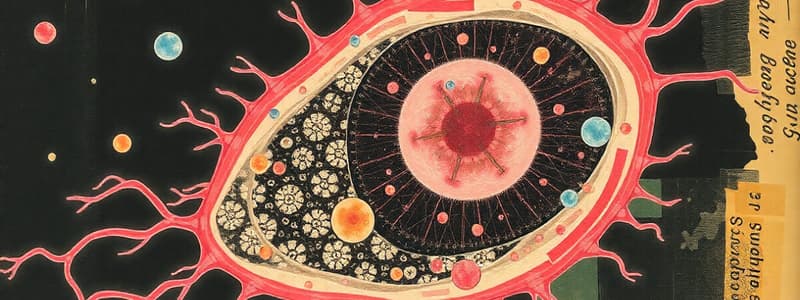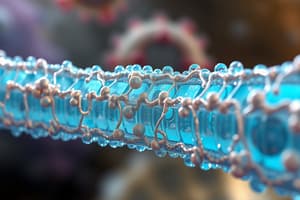Podcast
Questions and Answers
What is the primary function of the Golgi apparatus in a cell?
What is the primary function of the Golgi apparatus in a cell?
- Cell signaling
- Generation of ATP
- Protein packaging (correct)
- Fluid regulation
Which component primarily makes up the cell membrane?
Which component primarily makes up the cell membrane?
- Nucleic acids
- Carbohydrates
- Phospholipids (correct)
- Proteins
What model describes the structure of the cell membrane?
What model describes the structure of the cell membrane?
- Lipid bilayer model
- Cell membrane theory
- Fluid mosaic model (correct)
- Phospholipid model
Which of the following is NOT a function of the cell membrane?
Which of the following is NOT a function of the cell membrane?
Which type of cell membrane protein is responsible for facilitating gas exchange?
Which type of cell membrane protein is responsible for facilitating gas exchange?
Which organelle is primarily responsible for ATP production in the cell?
Which organelle is primarily responsible for ATP production in the cell?
Who is known as the father of modern physiology?
Who is known as the father of modern physiology?
According to cell theory, what is true about all living organisms?
According to cell theory, what is true about all living organisms?
Which component surrounds the cytoplasm and is crucial for the exchange of materials between the cell and its environment?
Which component surrounds the cytoplasm and is crucial for the exchange of materials between the cell and its environment?
What is the primary function of the cell membrane?
What is the primary function of the cell membrane?
What does the term 'active transport' refer to?
What does the term 'active transport' refer to?
Which component of a phospholipid is hydrophilic?
Which component of a phospholipid is hydrophilic?
What is an example of facilitated diffusion?
What is an example of facilitated diffusion?
Which of the following is NOT a factor affecting simple diffusion?
Which of the following is NOT a factor affecting simple diffusion?
What is the role of membrane proteins?
What is the role of membrane proteins?
Which process describes the movement of water and small molecules from high to low hydrostatic pressure?
Which process describes the movement of water and small molecules from high to low hydrostatic pressure?
How does bulk flow differ from other forms of transport?
How does bulk flow differ from other forms of transport?
Flashcards
What is the function of mitochondria?
What is the function of mitochondria?
Mitochondria are responsible for producing ATP (adenosine triphosphate), the primary energy source for cells. They are often called the 'powerhouses of the cell'.
What does the Golgi apparatus do?
What does the Golgi apparatus do?
The Golgi apparatus acts like a packaging and shipping center. It packages proteins into small sacs called vesicles and sends them to their destinations within the cell.
Describe the cell membrane's structure.
Describe the cell membrane's structure.
The phospholipid bilayer forms the cell membrane. It has two layers: the hydrophilic heads face outward while the hydrophobic tails face inward.
What is the primary function of the fluid mosaic model?
What is the primary function of the fluid mosaic model?
Signup and view all the flashcards
What role do proteins play in the cell membrane?
What role do proteins play in the cell membrane?
Signup and view all the flashcards
What is Physiology?
What is Physiology?
Signup and view all the flashcards
Who is Claude Bernard?
Who is Claude Bernard?
Signup and view all the flashcards
What is Cell Theory?
What is Cell Theory?
Signup and view all the flashcards
What is Cytoplasm?
What is Cytoplasm?
Signup and view all the flashcards
What are Mitochondria?
What are Mitochondria?
Signup and view all the flashcards
Cell Membrane
Cell Membrane
Signup and view all the flashcards
Active Transport
Active Transport
Signup and view all the flashcards
Passive Transport
Passive Transport
Signup and view all the flashcards
Simple Diffusion
Simple Diffusion
Signup and view all the flashcards
Facilitated Diffusion
Facilitated Diffusion
Signup and view all the flashcards
Bulk Flow
Bulk Flow
Signup and view all the flashcards
Filtration
Filtration
Signup and view all the flashcards
Membrane Proteins
Membrane Proteins
Signup and view all the flashcards
Study Notes
Cell Structure and Function
- Cell Membrane: It plays an important role in cell signaling & cell recognition. The cell membrane is a phospholipid bilayer. Proteins in the membrane help in signal transduction. Proteins are also involved in transporting materials.
- Cell Proteins: Proteins have two functions: one part interacts with the extracellular fluid and the other part interacts with the intracellular fluid.
- Cell Membrane Proteins: Transmembrane proteins pass completely through the membrane, while peripheral proteins are attached to the inner or outer face, or embedded in one side of the membrane.
- Cell Membrane Structures: Gap junctions, desmosomes, tight junctions, and channels allow the exchange of gases and other materials within the cell.
- Fluid Mosaic Model: The cell membrane is a fluid structure with proteins embedded within the phospholipid bilayer.
- Mitochondria: It is also called the powerhouse of the cell. It is involved in generating ATP (adenosine triphosphate).
- Golgi Apparatus: It is a refining/packaging system for cellular products. It is packaged in sacs called vesicles.
- Ribosomes: Plays a complex role in protein synthesis.
- Nucleus: The largest organelle in the cell. It contains the genetic material (DNA) and controls cellular activities.
- Cytoplasm: The fluid-like substance inside the cell, and all the organelles are suspended in it.
- Cell Transport: It transports substances in and out of the cell.
- Active Transport: The mechanism that requires energy. It is also called uphill transport because any substance may be transported against its concentration gradient.
- Passive Transport: The transport of substances does not require energy. It is also called downhill transport. Examples are simple diffusion and facilitated diffusion, which may move substances across the membrane.
- Simple Diffusion: It is the movement of materials from an area of high concentration to an area of low concentration. This can be influenced by factors such as temperature, surface area, and concentration gradient.
- Facilitated Diffusion: Substances move across the membrane with the help of carrier proteins.
- Bulk Flow: Movement of large quantities of molecules from an area of high pressure to an area of low pressure - Bulk flow is in the lungs (example).
- Filtration: It is the movement of water and small dissolved particles from an area of high hydrostatic pressure to an area of low hydrostatic pressure.
Studying That Suits You
Use AI to generate personalized quizzes and flashcards to suit your learning preferences.




